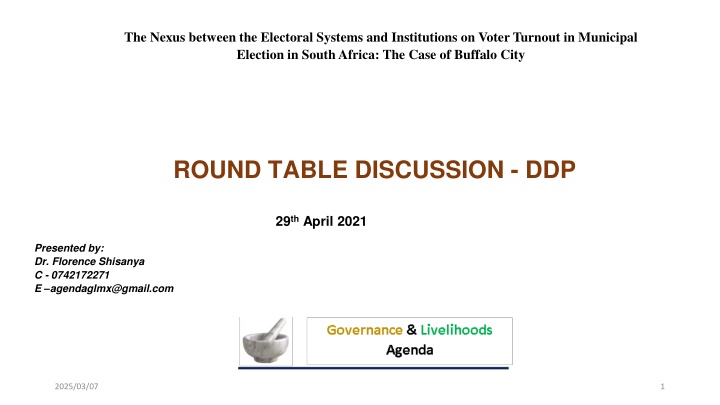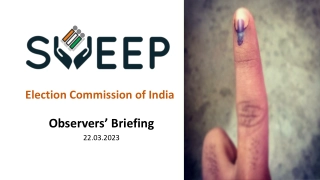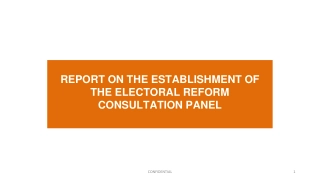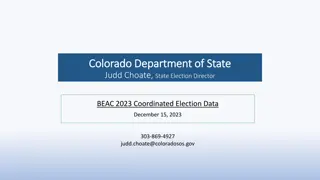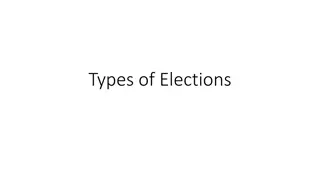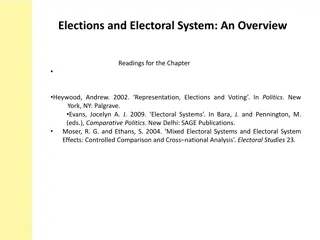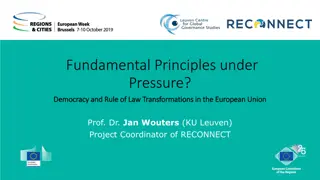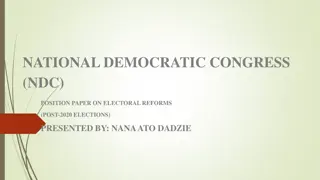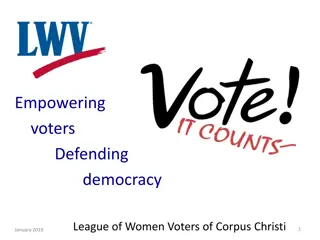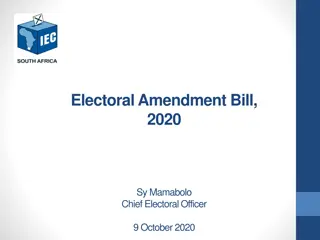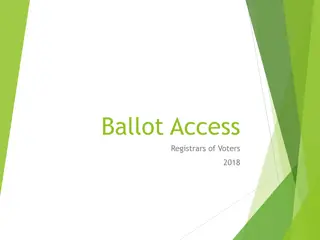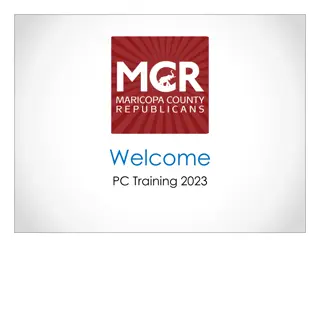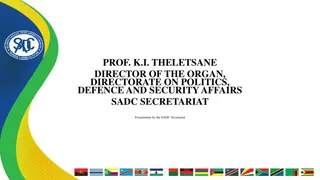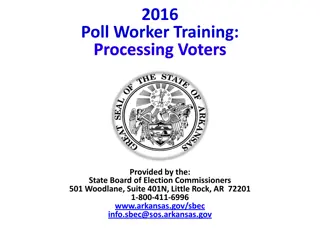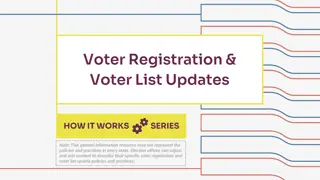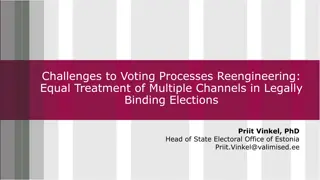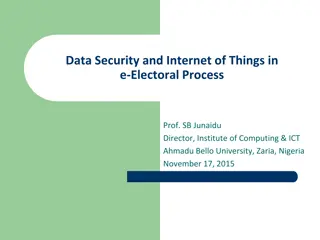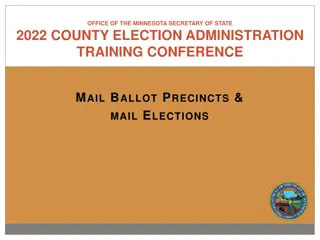The Nexus between Electoral Systems and Voter Turnout in Municipal Elections
Electoral systems play a crucial role in shaping voter turnout in municipal elections. This case study focuses on Buffalo City in South Africa, analyzing how different electoral systems impact voter participation. Explore the advantages of proportional representation and majoritarian systems, factors influencing voter turnout, and the 2016 election results in Buffalo City. Gain insights into how electoral rules influence voter behavior, election outcomes, and the overall democratic process.
Download Presentation

Please find below an Image/Link to download the presentation.
The content on the website is provided AS IS for your information and personal use only. It may not be sold, licensed, or shared on other websites without obtaining consent from the author.If you encounter any issues during the download, it is possible that the publisher has removed the file from their server.
You are allowed to download the files provided on this website for personal or commercial use, subject to the condition that they are used lawfully. All files are the property of their respective owners.
The content on the website is provided AS IS for your information and personal use only. It may not be sold, licensed, or shared on other websites without obtaining consent from the author.
E N D
Presentation Transcript
The Nexus between the Electoral Systems and Institutions on Voter Turnout in Municipal Election in South Africa: The Case of Buffalo City ROUND TABLE DISCUSSION - DDP 29th April 2021 Presented by: Dr. Florence Shisanya C - 0742172271 E agendaglmx@gmail.com 2025/03/07 1
OVERVIEW Electoral System Types of Electoral System (main) Advantages of PR and Majoritarian Electoral Systems Why Vote? Factors that influence voter turn out Local Government Elections in South Africa Buffalo City Metro Election 2016 Election Results Type of Electoral System and Voter Turn out in BCM
Electoral Systems Electoral (voting) system refer to a set of rules that regulate how elections are conducted and how their results are determined. Political electoral systems are organized by the government. Political electoral systems are defined by constitutions and electoral laws, are typically conducted by election commissions (IEC) and can use multiple types of elections for different offices. E.g (First Past the Post - FPTP), Majoritarian, Proportional Representative (PR), Mixed systems e.t.c These rules govern all aspects of the voting process: when, who (voter, candidate), how ballots are marked, cast, counted, how votes translate into the election outcome, limits on campaign spending e.t.c. Thus, Electoral rules, like any other institutions, influence not only the behavior and the choices of actors or agents or agents taking part in the election, but the character of the election as well. The level of voter participation in the elections is an important reflection of the effect of the electoral system or structure Different types of electoral systems affect voters in different ways.
Types of Electoral Systems Plurality System- a system in which the candidate/s with the highest number of votes wins, with no requirement to get a majority of votes. If there is a single position to be filled, it is known as first- past-the-post Majoritarian voting is a system in which candidates have to receive a majority of the votes to be elected, although in some cases only a plurality is required in the last round of counting if no candidate can achieve a majority. Proportional Representation involves voters voting for a list of candidates proposed by a party. Mixed systems involves use of two methods for example- part of the membership is elected by a plurality or majority vote in single-member constituencies and the other part by proportional representation. South Africa uses Mixed method
Advantages of Proportional Representation (PR) Can give minority parties and independent candidates a better chance of winning seats in Parliament. Ensures that the parties appeal to their core supporters, rather than a small number of so called swing voters in marginal seats. Can deliver fairer treatment of minority parties and independent candidate. Fewer votes are wasted as more people s preferences are taken into account Potentially offers greater and more-representative choice for voters. May encourage turn-out and reduce apathy. Ensures greater continuity of government and requires greater consensus in policy-making.
Advantages of FPTP/ Majoritarian Elected reps are more likely to tackle important local issues Promotes accountability to voters, no chance of ousted parties seeking to form coalition with other parties after election as in PR. Produces governments which have legislative voting majorities - legislative power necessary to implement their electoral manifesto.
Why Vote? Elections promotes accountability on the part of the leaders and improves their responsiveness to the general public. Elections help to resolve the issue of leadership succession by removing individual claims or entitlements to power Elections are a means of promoting political stability by ensuring a peaceful and orderly transfer of power from one individual or group to another especially in post-conflict states
Factors that influence voter turn out Socio economic factors e.g education, ethnicity e.t.c Costs of participation Knowledge Cultural factors trust in government, interest in politics, Belief in the efficacy of voting, degree of partisanship among the citizens. Institutional factors rules and laws, voter registration, salience, proportionality, compulsory voting, ease of voting, voter fatigue, campaigns (voter pledges).
Local Government Elections (Metro) in South Africa Councils are elected every five years. Municipal officials Mixed System; half the seats in local and metro councils come from the PR system and half from the constituency (ward) system. There are two main types of elections: one for metro councils and one for local councils (which includes district council elections). Only registered voters may vote. Metro Council voters: One Proportional Representation vote for a party contesting the metro council One ward vote for an individual candidate contesting the war
Buffalo City Municipality Election Results (IEC, 2016) Votes Seats List Party Ward List Total % Ward Total African National Congress 131,698 136,354 268,052 58.7 45 15 60 Democratic Alliance 53,374 53,416 106,790 23.4 5 19 24 Economic Freedom Fighters 17,697 18,693 36,390 8.0 0 8 8 African Independent Congress 6,731 8,869 15,600 3.4 0 4 4 12,255 12,255 2.7 0 0 Independent Pan Africanist Congress 1,877 2,228 4,105 0.9 0 1 1 United Democratic Movement 1,021 2,944 3,965 0.9 0 1 1 Congress of the People 1,655 2,258 3,913 0.9 0 1 1 African Christian Democratic Party 1,275 1,244 2,519 0.6 0 1 1 Others 955 1,766 2,721 0.6 0 0 0 Total 228,538 227,772 456,310 100.0 50 50 100 Spoilt votes 4,934 5,843 10,777
Type of Electoral System and Voter Turnout in BCM Different types of electoral systems affect voters in different ways (Blais and Aarts 2006). They shape the direction and intensity of competition between the parties as they operate within and around the rules in order to increase their chances of success in elections e.g It is argued that PR- attract participation of more votes. Dominant parties ANC, DA and EFF stifled electoral competition we have won anyway my vote will not make a difference Electoral system favored larger parties- the majoritarian system promoted a dominant party system (smaller parties and their supporters demotivated) Mixed electoral system shaped the constraints and incentives of the political parties and the voters in participating in the elections The PR system seem to have had a depressing effect on turnout in Buffalo City as all the variables affiliated with it have negative coefficients.
Conclusion and Recommendations Electoral systems present participating political parties with unique challenges and opportunities. Small parties and their supporters did not take full advantage of the PR system that gave them an advantage to compete Electoral system used in the 2016 Buffalo City municipal elections promoted a dominant party system- could lead to government ineffectiveness. Proportion of seats allocated through the PR system should be reviewed upwards to maybe 80% to ensure that local councils are more representative. A shift to an open-list system would also add an important incentive for the voters and the politicians and therefore improve turnout. Thank you
